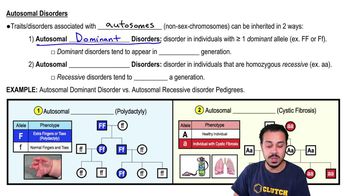Autosomal Inheritance quiz Flashcards
 Back
BackTerms in this set (8)
How do autosomal dominant disorders differ from autosomal recessive disorders in terms of allele requirements?
Autosomal dominant disorders require at least one dominant allele to be expressed, while autosomal recessive disorders require two recessive alleles.
Why do autosomal dominant disorders tend to appear in every generation?
Because individuals with at least one dominant allele will express the disorder, making it more likely to be present in each generation.
How do autosomal recessive disorders typically behave in terms of generational appearance?
Autosomal recessive disorders tend to skip generations because they require two recessive alleles to be expressed.
What is polydactyly and how is it inherited?
Polydactyly is an autosomal dominant disorder resulting in extra fingers or toes, inherited through at least one dominant allele.
What is cystic fibrosis and how is it inherited?
Cystic fibrosis is an autosomal recessive disorder, requiring two recessive alleles for the disorder to be expressed.
Why do autosomal recessive disorders often skip a generation?
Because they require two recessive alleles to be expressed, making it less likely for each generation to inherit both alleles.
How can you distinguish between autosomal dominant and autosomal recessive disorders in a pedigree?
Autosomal dominant disorders appear in every generation, while autosomal recessive disorders often skip generations.
What is the genetic requirement for an individual to express an autosomal recessive disorder?
The individual must have two recessive alleles (homozygous recessive) to express the disorder.


